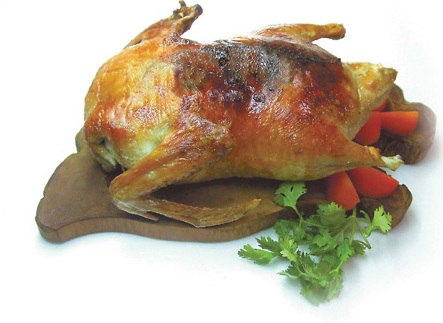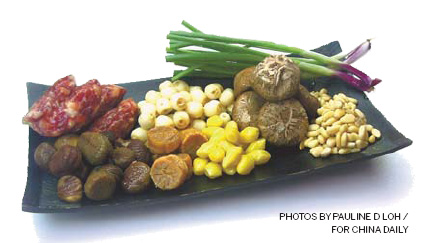Buried treasures

Duck is not often cooked, but when it is, it tends to be part of a festive meal. Pauline D Loh looks at a special duck recipe that is a gem of Chinese cuisine
My grandfather was a journalist in Shanghai at the turn of the century, and he often preferred the rich, sweet flavors of benbang cai (Shanghai cuisine) to the blander dishes of his native Cantonese.
I remember one of his favorite kitchen projects - a duck carefully deboned and stuffed with a cornucopia of delicious delights. He called it babao ya, or Eight Treasures Duck.
Grandpa's culinary efforts would turn the kitchen upside down for an entire day, but the end result was an awe-inspiring bird that sat in the center of the dining table, steaming gently in its crisp skin. The highlight of the meal was when he made the first incision and the stuffing would spill out like colorful jewels. It was a feast for the eyes, the nose and the palate.
My grandfather did not pass the recipe to me, and in my later years I went to great lengths to re-capture the taste of his Eight Treasures Duck.
There are many versions of the recipes collected in my encyclopedic collection of cookbooks, but it took years of experimenting before I could get it right.
First, there were the ingredients. This duck was traditionally stuffed with the sweet glutinous rice, the Shanghainese called babao fan, a sticky mess of sweet dates, chestnuts, lotus nuts and red bean paste.
My grandfather preferred a savory version, and he also preferred using normal rice, going to great lengths to seek out the best rice from Northeast China for his stuffing.
Then, the whole duck had to be steamed, and then deep-fried to get the tenderness that characterized the dish.
We were one of the first to have a massive gas oven put into the kitchen, and my grandpa decided it was a healthier way to cook.
Despite all these innovations, grandpa's Eight Treasures Duck became a celebrity dish, and the many chefs among his foodie friends started using his version on their menus.
Even to this day, when my family dines out, we still see this dish featured occasionally in some of the Chinese restaurants we patronize, and it brings back memories of my grandfather and his culinary adventures.
Recent research tells me that the Eight Treasures Duck was originally a palace kitchen specialty, popularized by the Qing emperor Qian Long (1711-1799). Perhaps he ate this during his sojourns south to Jiangsu and brought it back to Beijing, because there was no record of this in the imperial kitchen manuals before then.
This is a dish that takes some time to prepare, but it is a spectacular dish for entertaining and although it is a bit time consuming, it is actually quite simple to do. Besides, if you master this, you will have in your kitchen repertoire one of the great dishes of Chinese cuisine.
This is my version, updated and simplified, but losing none of its original flavors.
Ingredients (serves 4-6):

1 large duck, about 1.5 to 2 kg
1 tbsp light soy sauce
1 tsp sesame oil
1 tsp honey
Salt and pepper
For stuffing:
2 cups cooked rice
150 g dried lotus seeds, soaked
6-8 dried Chinese mushrooms, soaked and sliced
200 g cooked chestnuts
100 g Yunnan ham, diced
1 Chinese sausage, diced
8-10 dried Chinese red dates, soaked
100 g pine nuts
1 large bunch spring onions, chopped
Method:
1. Debone the duck. First, break off the thigh and wing joints so they can be removed easily. Next, use a sharp knife to cut around the rib cage, working your way right around the carcass. Reserve the carcass for soup.
2. Place the boned duck in a large mixing bowl and add the soy sauce, sesame oil, honey, salt and pepper. Work the marinade inside the bird as well. Let the duck sit while you prepare the stuffing.
3. Heat up some oil in a large wok or frying pan and throw in the chopped spring onions to flavor the oil. When the onions are sizzling, add the diced Yunnan ham and Chinese sausages.
4. Add the lotus seeds, sliced mushrooms and fry till lightly fragrant. Add the chestnuts, pine nuts, red dates next.
5. Finally, tip in the rice and toss thoroughly to coat. Season with more salt and pepper. Allow the rice to cool to room temperature.
6. Place the duck on a large roasting tin and carefully spoon the cooled stuffing into the duck. Pat the duck back into shape and use toothpicks or bamboo skewers to seal the neck opening and the bottom cavity.
7. Arrange the duck breast-side up on the rack and roast in a 200 C oven for 40 minutes until skin is crisp and golden.
8. Remove the bamboo skewers and plate the duck. Cut into portions and serve with the stuffing.
Food notes:
If you find it too daunting to even attempt to debone the duck, don't give up on the recipe. Crack the wing and thigh joints and then, hit the duck really hard to break most of the bones. This will help the duck cook a lot faster. I find a large rolling pin does the trick well. And if you are cooking the duck with bones intact, remember to give it an extra 10 minutes in the oven and rest it before you start carving. If you are serving the duck with bones, remove most of the stuffing so you can carve the meat easier.
I know many Chinese kitchens do not have Western ovens, but this dish can also be cooked the traditional way. Once you have the duck prepared, steam it over a high fire for about the same time - 40 minutes. After that, you need to heat up half a wok of oil till gently smoking. Lower the whole bird carefully into the pot and ladle hot oil over until the skin turns crisp and brown. Remember to turn up the heat just before you remove the duck so the hot oil drips off easily and there is less grease on the bird.
(China Daily 03/27/2010 page12)














